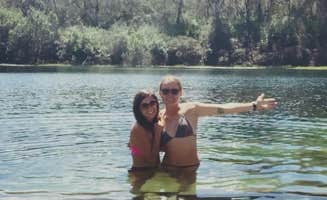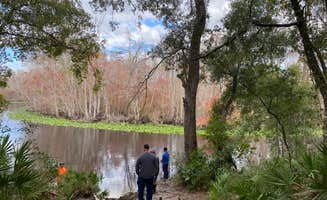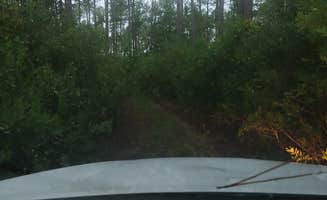Dispersed camping near Ormond Beach, Florida concentrates in the Ocala National Forest, where the terrain consists of sandy soil mixed with limestone features. The region experiences hot, humid summers with temperatures regularly exceeding 90°F and mild winters with occasional overnight frost. Most primitive sites require significant off-road navigation through subtropical forest with dense undergrowth and occasional standing water, particularly during the summer wet season from June through September.
What to do
Water exploration: Trout Lake Primitive Sites provide direct lake access for swimming and fishing. "Very narrow trails but really easy access, you will leave with some new pinstripes," notes camper Joe P. about reaching these secluded spots.
Wildlife observation: Lake Dorr offers opportunities to view native Florida wildlife, though safety considerations are important. The surrounding forest hosts numerous bird species, small mammals, and reptiles common to central Florida ecosystems.
Hiking forest trails: The Ocala National Forest features extensive trail networks connecting many dispersed camping areas. At Freak Creek Dispersed Camping, visitors report "It's super secluded and quiet" with good water access, as Adamm A. mentions, "Great place to put a kayak in the water."
What campers like
Stargazing opportunities: The distance from city lights makes forest camping spots excellent for night sky viewing. The limited tree cover at some sites enhances visibility of constellations and meteor showers during clear nights.
River access: Davenport Landing offers direct access to the Ocklawaha River. Stuart K. describes finding "an amazing little access point here to the Ocklawaha river that runs through this neck of the woods – which used to be a riverboat stop where steamboats would stop to fuel or disembark enroute to Silver Springs."
Privacy between sites: Many dispersed areas feature natural vegetation barriers creating private camping spaces. "Set of primitive spots near lake. Main road entry is packed dirt; smaller access road to sites is two-track about 1/4 mile through woods — very narrow tree clearance," notes Entropical Breeze E. about Trout Lake Primitive Sites.
What you should know
Vehicle requirements: Most dispersed sites require high-clearance or 4WD vehicles. At Blue Sink, Destiny R. advises "You may need ATV or creative backpacking to get there now. The Forestry Service recently chopped down trees and covered the easy access roads."
Safety considerations: Some areas have safety concerns. Michael S. warns about Lake Dorr: "Spoke to a local that warned of violence, robbery, and killings in this area of the national forest."
Site conditions vary significantly: Campsite quality and cleanliness fluctuate throughout the year and between locations. At Trout Lake, one visitor observed sites were "Not the cleanest but passable," while noting "Poor cell service even with booster."
Tips for camping with families
Select accessible sites: For families with young children, choose sites with shorter access trails and established clearings. David P. notes about Davenport Landing: "Pulled in around 9:30 pm. Big open spot. Last 100 yards driving back in were very bumpy but no problem with our van."
Pack adequate water: No potable water exists at any dispersed sites in the forest, requiring families to bring all drinking water. The subtropical climate increases daily water needs, particularly during summer months.
Prepare for limited facilities: St. Johns River Dispersed Spot and other primitive sites lack bathroom facilities or trash service. All waste must be packed out, and proper food storage is essential to prevent wildlife encounters.
Tips from RVers
Size restrictions: Only smaller recreational vehicles can access most dispersed sites. According to Entropical Breeze E., "Just barely scraped a FWD Promaster through the trees, into a pullout just before sand started. 4WD recommended."
Ground conditions: Sandy soil throughout the forest creates traction challenges for heavier vehicles. "Got stuck in sand on the way out and had to wait for a tow truck," reports Michael S. about attempting to navigate forest roads with an RV.
Limited turnaround space: Many forest roads end without adequate turning areas for larger vehicles. Drivers should scout ahead before attempting to navigate narrow access roads in larger rigs.




